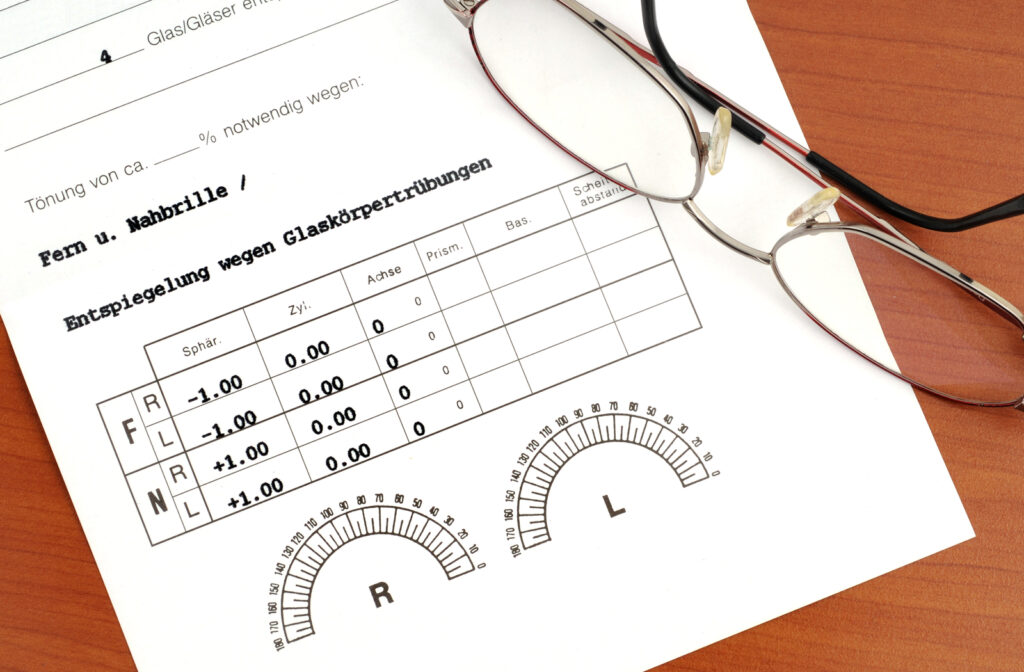A Second Look At Your Prescription
Like every other person who wears eyeglasses, you probably have a 10-year-old backup pair of lenses collecting dust in your junk drawer! But should you actually reach for them if your current pair gets broken or lost?
Your eyewear prescription has an expiration date, just like your prescription medication, and you may be wondering what that’s all about.
Let’s explore why eyeglass prescriptions are only valid for a certain number of years, and why we shouldn’t purchase or wear lenses with an expired prescription.
It’s the Law
It’s an exciting time in the eyewear world! Many new brands, styles, and colors are available, and there are many different ways to purchase your lenses.
In the past, there weren’t as many options for eyeglass and contact lens wearers. Patients would receive a prescription from their optometrist, and purchase their eyewear on the spot, with prescriptions lasting up to five years.
Nowadays, your prescription expires much sooner.
States wanted patients to undergo more frequent eye exams to ensure accurate prescriptions. Governing bodies implemented new laws to shorten prescription lengths, working together with a nationwide law for eye doctors, who must provide patients with their prescription after an eye exam.
The eyeglass lens prescription you receive from an optometrist includes an expiration date. This date indicates the last day you can purchase new eyeglasses or replacement lenses using that prescription.
It is illegal for an optician to create lenses from an expired prescription. If you are purchasing eyewear from a reputable source, they will advise you of your expired prescription and recommend it be updated.
Patients should be wary of companies willing to sell corrective lenses without a valid prescription.
Why Does My Prescription Have An Expiration Date?
As we age, our eyesight changes. An expired prescription may not provide you with the clearest vision. Your vision could have deteriorated since your last eye exam, making your prescription inaccurate or obsolete.
Eyeglasses with out-of-date prescriptions can cause eye strain, headaches, or potentially a serious accident due to blurred vision. New eyeglasses with an accurate, up-to-date prescription can significantly improve the quality of your vision.
Signs of An Expired Prescription
Changes to your eyesight happen gradually, so you may not notice a difference in your vision right away. Here are some common signs that indicate it’s time to update your prescription:
- Headaches
- Squinting
- Eyestrain
- Fatigued eyes
- Blurred vision
- Double vision
- Light sensitivity
- Nausea
Contact your optometrist for a comprehensive eye exam if you’re experiencing any of the above vision problems.
It’s vital to note that other eye conditions have similar symptoms to an expired prescription, so make plans to visit your eye doctor anytime you experience changes to your vision.
How Often Should I Have An Eye Exam?
Even if your prescription stays constant at each visit to your optometrist, you should continue with routine eye exams to help prevent the development of eye conditions like glaucoma, or diabetic eye diseases.
The American Optometric Association (AOA) recommends a comprehensive eye exam every 2 years for low-risk adults between 18 and 64. Adults over 65 are recommended to have an eye exam every year, because they’re more susceptible to developing age-related eye conditions.
School-aged children should have an eye exam every year to help catch and correct vision problems that could affect their school performance or extracurricular activities.
Regardless of age or health, routine eye exams are vital in ensuring crisp, clear, and comfortable vision.
How Long Will My Prescription Last?
The expiration date on eyeglass prescriptions varies from state to state.
In California, you can expect your prescription to last for up to 2 years. However, the expiration date on a prescription may be shorter if there’s a risk of eyesight changing quickly, like a child with myopia (nearsightedness) or a patient with keratoconus.
What About My Contact Lenses?
A contact lens prescription is different from an eyeglass prescription. The lens sits directly on your eye, and the optometrist must adjust your prescription to accommodate these requirements.
Like eyeglass prescriptions, contact lens prescriptions have an expiration date. The State of California sets the expiration date, and for low-risk prescriptions, it’s between 1-2 years. Patients with high-risk vision may have a shorter time before their expiration date.
Contact lens prescriptions have a shorter expiration than eyeglass lens prescriptions. Lens wearers are encouraged to have their eyesight evaluated annually to help ensure the lenses are not damaging the eye’s surface or causing eye infections.
What’s Next?
If your eyeglass prescription has expired, you’ll need to book a comprehensive eye exam to get a new prescription.
At the beginning of your exam, the team asks a few questions about your life and medical history. Following this, your eyes are given a series of tests to determine your prescription.
Your optometrist discusses any prescription changes and provides the necessary details about their findings at the end of your appointment.
State law requires that your eye doctor provides you with your prescription, whether you intend to purchase glasses from them or not.
If you have more questions about your prescription, or need to book an appointment for your next eye exam, you’ve come to the right place. Total Vision provides stellar eye care services across the state of California.
We’ll help you get in touch with one of our knowledgeable and friendly optometrists, and get you started on the path to clearer vision!



